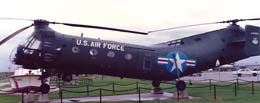|
Piasecki |
|
|
H-21
Workhorse / Shawnee
|
%20(8X4).jpg)
|
CH-21 Shawnee
Photo: Robert Deering 1969
Idlewild AAF (A805)
Taegu, Korea |
|
The
Piasecki H-21 Workhorse/Shawnee
is an American helicopter, the fourth of a
line of tandem rotor helicopters designed
and built by Piasecki Helicopter (later
Boeing Vertol). Commonly called the "flying
banana", it was a multi-mission helicopter,
utilizing wheels, skis, or floats.
The H-21 was originally developed by
Piasecki as an Arctic rescue helicopter. The
H-21 had winterization features permitting
operation at temperatures as low as -65°F,
and could be routinely maintained in severe
cold weather environments.
|
Variants
- XH-21
- USAF designation of the first H-21
prototype.
- YH-21 Work Horse
- USAF Search And Rescue (SAR) version
of the HRP-2 for service test, eighteen
built
- H-21A Work Horse (Model 42)
- Same as YH-21 with detailed changes
and powered by one 1250hp Wright
R-1820-102, re-designated CH-21A in
1962, 32 built for USAF, 6 for the Royal
Canadian Air Force)
- H-21B Work Horse (Model 42)
- Same as H-21A but with uprated
Wright engine (1425hp) and seats for 20
troops, autopilot as standard and
limited armour protection and external
fuel tanks, became CH-21B in 1962, 163
built for U.S. forces. 10 built for
Japanese Self-Defense Forces; 10 H-21B
built for the French Navy.
- SH-21B Work Horse
- Rescue conversion of the H-21B,
became HH-21B in 1962.
- H-21C Shawnee (Model 43)
- US Army version of the H-21B, became
CH-21C in 1962, 334 built for U.S.
forces. 32 built under license by Weser
Flugzeugbau for the West German Army. 98
built for the French Air Force and
French Army Aviation (ALAT).
- XH-21D Shawnee (Model 71).
- Two H-21Cs re-engined with two
General Electric T58 turboshaft engines
in place of the Wright R-1820. Not
placed into production.
- CH-21A
- H-21A redesignated in 1962.
- CH-21B
- H-21B redesignated in 1962.
- CH-21C
- H-21C redesignated in 1962.
- HH-21B
- SH-21B redesignated in 1962.
- Model 42A
- Conversion by Vertol Aircraft
(Canada) of eight Royal Canadian Air
Force H-21s for civilian use. Equipped
to carry 19 passengers or 2,820lb
(1,279kg) of internal cargo or a 5,000lb
(2,268kg) slung load.
- Model 44A
- Commercial 19-passenger transport
version of the H-21B. 11 total (as
HKP-1), 2 for the Swedish Air Force, 9
for the Swedish Navy. 2 used for
test/evaluation purposes by Japan
Self-Defense Forces.
- Model 44B
- Commercial 15-passenger/freighter
version of the H-21B.
- Model 44C
- Commercial eight-passenger executive
version of the H-21B.
- CH-127
- Vertol Canada Model 44
|
%20(8X4).jpg)
CH-21B
Workhorse
Photo:
Robert Deering 10/18/2012
National Museum of
the USAF
Wright-Patterson AFB (FFO)
Dayton, Ohio |
|
|

CH-21B Workhorse
Photo: Robert
Deering 1986
USS Alabama Museum
Mobile, Alabama |
|
|
%20(8X5.3).jpg)
CH-21C Shawnee
Photo,
Robert Deering 7/16/2014
American
Helicopter Museum
Brandywine
Airport (OQN)
West
Chester, Pennsylvania |
|
|
%20(8X4).jpg)
CH-21C Shawnee
Photo: Robert Deering 1969
Idlewild AAF (A805)
Taegu, Korea |
|
|
|
|
|
SPECIFICATIONS: |
PERFORMANCE:
|
Rotor Span:
44 ft 0 in
(13.41 m)
Length:
52 ft 6 in (16.01 m)
Height:
15 ft 9 in (4.80 m)
Empty Weight: 8,950 lb (4,058
kg)
Gross Weight:
15,200 lb
(6,893 kg)
Crew:
3–5 (Pilot, co-pilot,
crew chief and one or two gunners)
Capacity:
20
troops or 12 stretchers
|
Maximum
speed:
127 mph (110
knots, 204 km/h)
Cruising
speed:
98 mph (85
knots, 158 km/h)
Range:
265 mi (230 nmi, 427
km)
Service
ceiling:
9,450 ft
(2,880 m) |
|
Engines:
1 × Wright
R-1820-103 radial engine, 1,425 hp
(1,063 kW) driving 2 rotors |
|
Armament:
Varying, but usually one or two
.50 (12.7 mm) or 7.62 mm M60 machine
guns. |
| |
|
|
SOURCE:
Wikipedia |
|
|
| |
|

USAF
Fact Sheet |
|
|
|
%20(8X4).jpg)



%20(8X4).jpg)

%20(8X5.3).jpg)
%20(8X4).jpg)